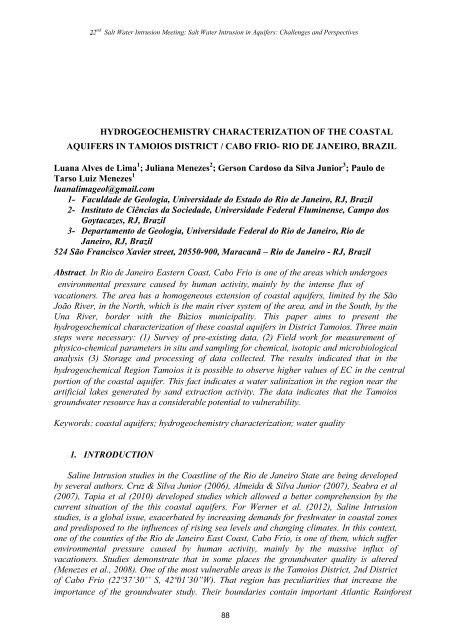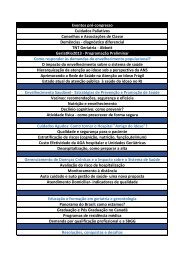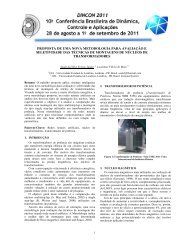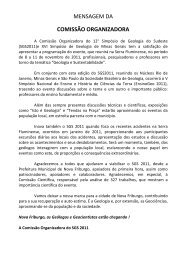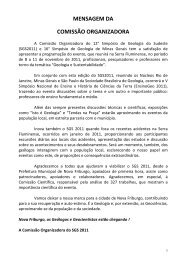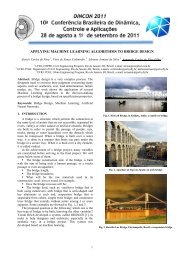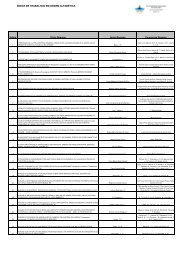Here - Meta Marketing e Eventos
Here - Meta Marketing e Eventos
Here - Meta Marketing e Eventos
- No tags were found...
Create successful ePaper yourself
Turn your PDF publications into a flip-book with our unique Google optimized e-Paper software.
2 nd Salt Water Intrusion Meeting: Salt Water Intrusion in Aquifers: Challenges and PerspectivesHYDROGEOCHEMISTRY CHARACTERIZATION OF THE COASTALAQUIFERS IN TAMOIOS DISTRICT / CABO FRIO- RIO DE JANEIRO, BRAZILLuana Alves de Lima 1 ; Juliana Menezes 2 ; Gerson Cardoso da Silva Junior 3 ; Paulo deTarso Luiz Menezes 1luanalimageol@gmail.com1- Faculdade de Geologia, Universidade do Estado do Rio de Janeiro, RJ, Brazil2- Instituto de Ciências da Sociedade, Universidade Federal Fluminense, Campo dosGoytacazes, RJ, Brazil3- Departamento de Geologia, Universidade Federal do Rio de Janeiro, Rio deJaneiro, RJ, Brazil524 São Francisco Xavier street, 20550-900, Maracanã – Rio de Janeiro - RJ, BrazilAbstract. In Rio de Janeiro Eastern Coast, Cabo Frio is one of the areas which undergoesenvironmental pressure caused by human activity, mainly by the intense flux ofvacationers. The area has a homogeneous extension of coastal aquifers, limited by the SãoJoão River, in the North, which is the main river system of the area, and in the South, by theUna River, border with the Búzios municipality. This paper aims to present thehydrogeochemical characterization of these coastal aquifers in District Tamoios. Three mainsteps were necessary: (1) Survey of pre-existing data, (2) Field work for measurement ofphysico-chemical parameters in situ and sampling for chemical, isotopic and microbiologicalanalysis (3) Storage and processing of data collected. The results indicated that in thehydrogeochemical Region Tamoios it is possible to observe higher values of EC in the centralportion of the coastal aquifer. This fact indicates a water salinization in the region near theartificial lakes generated by sand extraction activity. The data indicates that the Tamoiosgroundwater resource has a considerable potential to vulnerability.Keywords: coastal aquifers; hydrogeochemistry characterization; water quality1. INTRODUCTIONSaline Intrusion studies in the Coastline of the Rio de Janeiro State are being developedby several authors. Cruz & Silva Junior (2006), Almeida & Silva Junior (2007), Seabra et al(2007), Tapia et al (2010) developed studies which allowed a better comprehension by thecurrent situation of the this coastal aquifers. For Werner et al. (2012), Saline Intrusionstudies, is a global issue, exacerbated by increasing demands for freshwater in coastal zonesand predisposed to the influences of rising sea levels and changing climates. In this context,one of the counties of the Rio de Janeiro East Coast, Cabo Frio, is one of them, which sufferenvironmental pressure caused by human activity, mainly by the massive influx ofvacationers. Studies demonstrate that in some places the groundwater quality is altered(Menezes et al., 2008). One of the most vulnerable areas is the Tamoios District, 2nd Districtof Cabo Frio (22º37’30’’ S, 42º01’30”W). That region has peculiarities that increase theimportance of the groundwater study. Their boundaries contain important Atlantic Rainforest88


